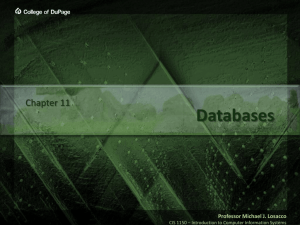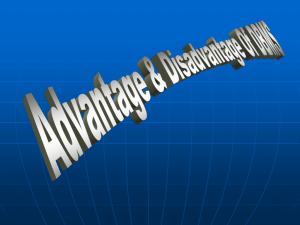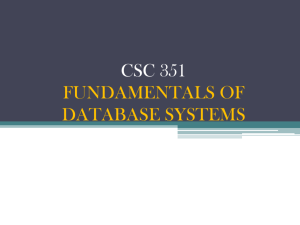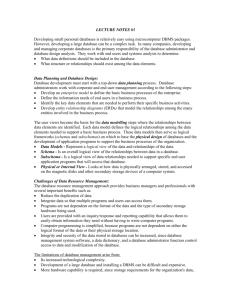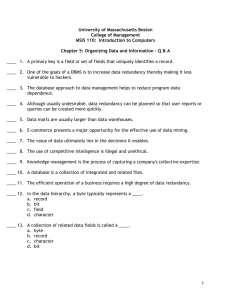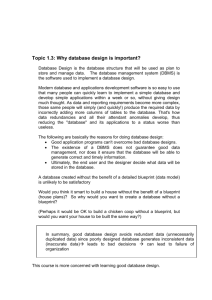Database Systems - a.thanop somprasong
advertisement
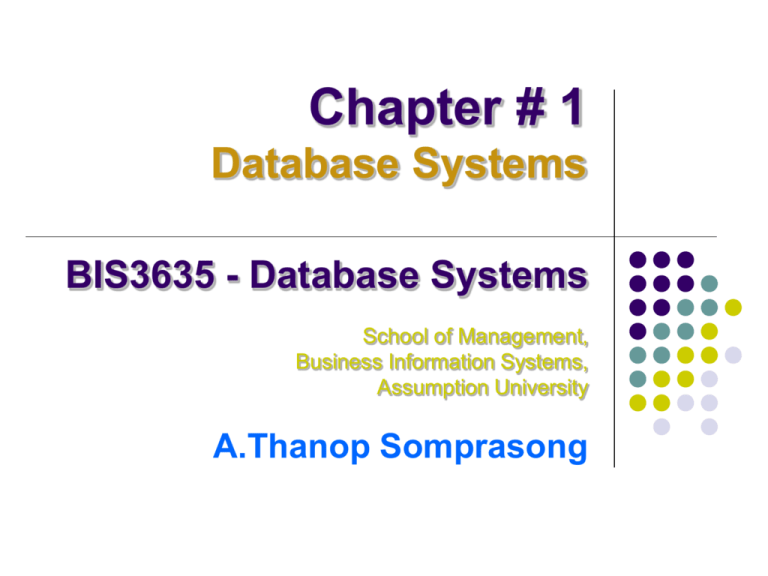
Chapter # 1 Database Systems BIS3635 - Database Systems School of Management, Business Information Systems, Assumption University A.Thanop Somprasong Objectives The differences between data and information What a database is What the various types of databases are Why they are valuable assets for decision making The importance of database design How modern databases evolved from file systems About flaws in file system data management What the database system’s main components are How a database system differs from a file system The main functions of a database management system (DBMS) Introduction Good decisions require good information derived from raw facts Data managed most efficiently when stored in a database Databases evolved from computer file systems Understanding file system characteristics is important Data vs. Information Data are raw facts Information is the result of processing raw data to reveal meaning (Foundation of decision making) Information requires context to reveal meaning Raw data must be formatted for storage, processing, and presentation Data are the foundation of information, which is the bedrock of knowledge Information produced by processing data Information used to reveal meaning in data Accurate, relevant, timely information is the key to good decision making Good decision making is the key to organizational survival “DIKY” Hierarchy (+) (4) Wisdom: The collective and individual experience of applying knowledge to the solution of problem; knowing when, where, and how to apply knowledge. (2) Information: Data organized into categories of understanding (3) Knowledge: Concepts, experience, and insight that provide a framework for creating, evaluating, and using information (1) Data: Flow of captured events or transactions. Introducing the DB and the DBMS Database : shared, integrated computer structure that stores a collection of data End-user data: raw facts of interest to the end user Metadata : data about data Metadata provides description of data characteristics and relationships in data Complements and expands value of data Database management system (DBMS) : collection of programs Manage structure and control access to data Role and Advantages of the DBMS DBMS is the intermediary between the user and the database Database structure stored as file collection Access database through the DBMS DBMS enables data to be shared DBMS integrates many users’ views of the data Role and Advantages of the DBMS (2) Role and Advantages of the DBMS (3) Advantages of a DBMS: Improved data sharing Improved data security Better data integration Minimized data inconsistency Improved data access Improved decision making Increased end-user productivity Types of Databases Databases can be classified according to: Number of users Database location(s) Expected type and extent of use (1) Number of users Single-user database supports only one user at a time Desktop database supports single-user, runs on PC Multiuser database supports multiple users at the same time Workgroup database supports a small number Enterprise database supports a large number Types of Databases (2) (2) Database location(s) Centralized database: data located at a single site Distributed database: data distributed across several different sites (3) Expected type and extent of use Operational database: supports a company’s day-to-day operations Transactional or production database Data warehouse: stores data used for tactical or strategic decisions Types of Databases (3) Unstructured data exist in their original (raw) state Structured data result from formatting Structure applied based on type of processing to be performed Types of Databases (4) X2 = Vendor offers single-user/personal DBMS version. Why database design is important ? Database design focuses on design of database structure used for end-user data Designer must identify database’s expected use Well-designed database (Positive): Facilitates data management Generates accurate and valuable information Poorly designed database (Negative): Causes difficult-to-trace errors Historical Roots: Files & File Systems Reasons for studying file systems : Complexity of database design easier to understand Understanding file system problems helps to avoid problems with DBMS systems Knowledge of file system useful for converting file system to database system File systems typically composed of collection of file folders, each tagged and kept in cabinet Organized by expected use Historical Roots: Files & File Systems (2) Contents of each file folder logically related Manual system served as a data repository for small data collections Cumbersome for large collections Data processing (DP) specialist converted computer file structure from manual system Wrote software that managed the data Designed the application programs Initially, computer files systems resembled manual systems Historical Roots: Files & File Systems (3) As number of files increased, file systems evolved Each file used its own application program to store, retrieve, modify data Each file owned by individual or department that commissioned its creation Data processing (DP) manager supervised the DP department DP department’s primary activity remained programming Historical Roots: Files & File Systems (4) Historical Roots: Files & File Systems (5) Historical Roots: Files & File Systems (6) Problems with File System Data Management File system an improvement over manual system File systems used for more than two decades (Too old) Understanding the shortcomings of file systems aids in development of modern databases Many problems not unique to file systems Even simple file system retrieval task required extensive programming Ad-hoc queries impossible Changing existing structure difficult Problems with File System Data Management (2) Security features difficult to program Often omitted in file system environments Summary of file system limitations: Requires extensive programming Can not perform ad-hoc queries System administration complex and difficult Difficult to make changes to existing structures Security features likely to be inadequate Structural and Data Dependence Structural dependence: access to a file dependent on its own structure All file system programs must be modified to conform to a new file structure Structural independence: change file structure without affecting data access Data dependence: data access changes when data storage characteristics change Data independence: data storage characteristics do not affect data access Structural and Data Dependence (2) Practical significance of data dependence is difference between logical and physical format Logical data format: how human views the data Physical data format: how computer must work with data Each program must contain: Lines specifying opening of specific file type Record specification Field definitions Field Definitions and Naming Conventions Storing customer name as single field is a liability Better record definition breaks fields into component parts Selecting proper field names important; field names are descriptive With proper naming conventions, file structure becomes self-documenting Some software places restrictions on length of field names Each record should have unique identifier or ID Field Definitions and Naming Conventions (2) Data Redundancy File system structure makes it difficult to combine data from multiple sources Vulnerable to security breaches Organizational structure promotes storage of same data in different locations Islands of information Data stored in different locations unlikely to be updated consistently Data redundancy: same data stored unnecessarily in different places Data Redundancy (2) Data inconsistency: different and conflicting versions of same data occur at different places Data anomalies: abnormalities when all changes in redundant data not made correctly Update anomalies Insertion anomalies Deletion anomalies Database Systems Database system consists of logically related data stored in a single logical data repository May be physically distributed among multiple storage facilities DBMS eliminates most of file system’s problems Current generation stores data structures, relationships between structures, access paths Takes care of defining, storing, managing all access paths and components Database Systems (2) The Database System Environment Database system: defines and regulates the collection, storage, management, use of data Five major parts of a database system: Hardware Software People Procedures Data The Database System Environment (2) The Database System Environment (3) Hardware: all the system’s physical devices Software: three types of software required: Operating system software DBMS software Application programs and utility software People: all users of the database system: System and database administrators Database designers Systems analysts and programmers End users The Database System Environment (4) Procedures: instructions and rules that govern the design and use of the database system Data: the collection of facts stored in the database Notes: Database systems created and managed at different levels of complexity Database solutions must be cost-effective as well as tactically and strategically effective Database technology already in use affects selection of a database system DBMS Functions Most functions transparent to end users Can only be achieved through the DBMS Can be categorized into 9 critical functions 1. Data dictionary management DBMS stores definitions of data elements and relationships (Metadata) in a data dictionary DBMS looks up required data component structures and relationships Changes automatically recorded in the dictionary DBMS provides data abstraction, removes structural and data dependency DBMS Functions (2) DBMS Functions (3) 2. Data storage management DBMS creates and manages complex structures required for data storage Also stores related data entry forms, screen definitions, report definitions, etc. Performance tuning: activities that make the database perform more efficiently DBMS stores the database in multiple physical data files DBMS Functions (4) 3. Data transformation and presentation DBMS transforms data entered to conform to required data structures DBMS transforms physically retrieved data to conform to user’s logical expectations 4. Security management DBMS creates a security system that enforces user security and data privacy Security rules determine which users can access the database, which items can be accessed, etc. DBMS Functions (5) 5. Multiuser access control DBMS uses sophisticated algorithms to ensure concurrent access does not affect integrity 6. Backup and recovery management DBMS provides backup and data recovery to ensure data safety and integrity Recovery management deals with recovery of database after a failure Critical to preserving database’s integrity DBMS Functions (6) 7. Data integrity management DBMS promotes and enforces integrity rules Minimizes redundancy Maximizes consistency Data relationships stored in data dictionary used to enforce data integrity Integrity especially important in transaction-oriented database systems DBMS Functions (7) 8. Database access languages and application programming interfaces DBMS provides access through a query language Query language is a nonprocedural language Structured Query Language (SQL) is the de facto* query language Standard supported by majority of DBMS vendors De facto* : It is a Latin expression that means "concerning the fact“, “actual”, “factual”, “true”, “real” or “genuine;”. Source : Wikipedia DBMS Functions (8) 9. Database communication interfaces Current DBMSs accept end-user requests via multiple different network environments Communications accomplished in several ways: End users generate answers to queries by filling in screen forms through Web browser DBMS automatically publishes predefined reports on a Web site DBMS connects to third-party systems to distribute information via e-mail Managing the Database System : A Shift in Focus Disadvantages of database systems: Increased costs Management complexity Maintaining currency (circulation) Vendor dependence Frequent upgrade/replacement cycles THE END


